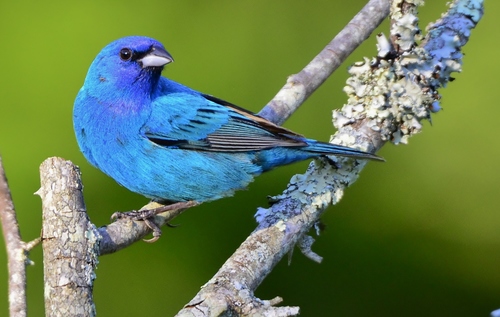
Indigo Bunting
The Indigo Bunting (Passerina cyanea) is a small, vibrant songbird renowned for the brilliant blue plumage of the breeding male. These birds are a common sight in eastern North America, inhabiting brushy fields, roadsides, and forest edges. They play a crucial role in controlling insect populations and dispersing seeds. While not culturally significant in the same way as some larger or more iconic birds, their striking beauty and melodious song make them a favorite among birdwatchers. Indigo Buntings are important study subjects for understanding avian navigation, as they use the stars to guide their nocturnal migrations.
11.5-13 cm
Length
18-23 cm
Wingspan
Least Concern
Conservation Status
Distribution
Breeds across eastern and central North America, from southern Canada to the southern United States. Winters in Central America, the Caribbean, and northern South America. Migrates primarily at night.
Lifespan
Typically 2-3 years in the wild, up to 10 years in captivity.
Indigo Bunting's Habitat
Habitat Types
Brushy fields, Forest edges, Roadsides, Open woodlands, Powerline clearings
Climate Zones
Temperate, Subtropical
Adaptations
Indigo Buntings prefer edge habitats, which provide a mix of open areas for foraging and dense vegetation for nesting and cover. They are adaptable to a variety of disturbed habitats created by human activity.
Variations
No recognized subspecies. Some regional variation in plumage brightness and song has been observed, but these differences are not consistent enough to warrant subspecies designation.
Appearance
Breeding Plumage
Breeding males are a vibrant, iridescent blue. Females and non-breeding males are brown with faint streaks and hints of blue on the wings and tail.
Seasonal Feather Changes
Males molt into a brown non-breeding plumage after the breeding season, resembling females.
Sex Based Plumage Differences
Highly pronounced during breeding season; males bright blue, females brown.
Notable Features
Short, conical bill adapted for seed-eating., Bright blue breeding plumage in males (iridescent)., Brown streaked plumage in females and immature birds.
Diet and Feeding
Primary Foods
Seeds, Insects, Berries, Spiders
Foraging Behavior
Forages on the ground and in low vegetation. Gleans insects from leaves and stems, and picks seeds from plants. During migration, may forage in small flocks.
Specializations
Conical bill is well-suited for cracking seeds. Also adept at catching insects on the wing.
Seasonal Diet Variations
Diet shifts with the seasons. Primarily insects during the breeding season, providing protein for nestlings. Seeds and berries are more important during migration and winter.
Behavior
Social Structure
Generally solitary or in pairs during the breeding season. May form small flocks during migration and winter.
Communication
Complex songs used by males to defend territories and attract mates., Sharp 'chip' calls used for alarm and communication between individuals., Flight calls given during migration.
Migration
Migrates at night, using the stars for navigation. Travels long distances between breeding and wintering grounds.
Territorial or Group Behaviors
Males are highly territorial during the breeding season, defending their territories against other males. Females may also defend nesting sites.
Conservation
Threats
Habitat loss due to agriculture and development., Collisions with windows and other structures., Pesticide exposure., Nest parasitism by Brown-headed Cowbirds.
Protection Programs
The Migratory Bird Treaty Act protects Indigo Buntings in the United States., Habitat conservation efforts, such as preserving and restoring grasslands and shrublands.
Local National Laws
Protected under the Migratory Bird Treaty Act in the US.
Population Trend
Stable
Population Estimates
Global population estimated at 28 million.
Interesting Facts
Indigo Buntings learn their songs.
Unlike many bird species, their songs are not entirely innate. Young males learn their songs from older males during their first breeding season.
They use the stars to navigate during migration.
Indigo Buntings are nocturnal migrants and have been shown to use the stars as a compass to guide their journeys.
The blue color of the male's plumage is structural, not pigment-based.
Tiny structures in the feathers scatter light, creating the brilliant blue appearance. This is similar to how a blue sky is formed.
Faqs about Indigo Bunting
What do Indigo Buntings eat?
They eat a variety of seeds, insects, berries, and spiders. Their diet changes with the seasons, with insects being more important during breeding.
Where do Indigo Buntings nest?
They build cup-shaped nests low in shrubs, dense vegetation, or sometimes in small trees.
How can I attract Indigo Buntings to my yard?
Provide a mix of open areas and dense vegetation, offer seed feeders (especially thistle/nyjer seed), and avoid using pesticides.
Are Indigo Buntings endangered?
No, they are classified as 'Least Concern' by the IUCN, meaning their populations are currently stable.
Why is the male Indigo Bunting blue but the female is brown?
This is an example of sexual dimorphism. The bright blue color helps males attract mates, while the brown color helps females camouflage while nesting.
Copyright @ Nature Style Limited. All Rights Reserved.
 English
English